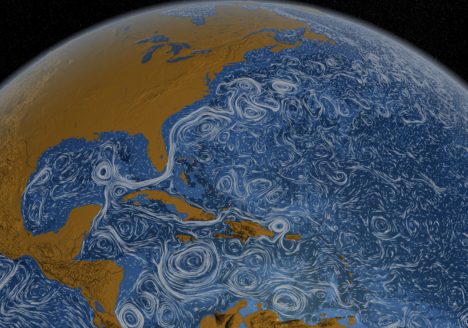Journey to the Center
Understanding what goes on in the deep underground has applications in geothermal energy, finding groundwater reservoirs, deposition of CO2, and prediction of earthquakes.
Which child hasn’t at some point wondered what would happen if you were to dig a hole all the way to the opposite side of the Earth? The famous French novelist Jules Verne (1828-1905), by many considered the founder of the science fiction genre, took things a step further as he let his imagination send a crew on a “Journey to the Center of the Earth”.
Today, we know well that such a mission wouldn’t get far. We understand that below our planet’s relatively thin solid crust, hot streams of fluid stone and metal make direct human exploration suicidal. Still, we cannot stop speculating about the conditions in the deep underground. Not only are we born curious, but developments in the underground influence our life in many ways. Millions of people live in areas that are subject to earthquake hazards, and knowledge about where to find groundwater resources is key to sustain living conditions in many areas.
A relatively young field is exploitation of geothermal energy. Due to the elevated temperatures in the deep underground, there is plenty of energy to be harvested. Moreover, geothermal energy does not produce CO2 nor pollute. Identifying the best geological sites for geothermal energy is a discipline of growing interest. Another emerging field is identifying geological structures which are suited for CO2 storage. Given the urgency of the climate crisis, increasingly more governments opt for capturing CO2 from energy production and industrial plants and store it underground.
“How do we investigate these topics, when we cannot send neither humans nor robots into the deep underground? The answer is to go there digitally.”
Seismic waves travel the underground
How do we investigate all these topics, when we cannot send neither humans nor robots into the deep underground? The answer is to go there digitally. This is the scope of the Solid Earth and Computational Geoscience group at NBI.
Unlike Jules Verne, who could leave things to his rich imagination, the researchers need to be sure that their visualizations reflect the true conditions. And since, again, it is not possible to probe these conditions with on-location sensors, scientists have to make do with so-called seismic investigations. Investigators will send acoustic waves through the geological layers, or initiate controlled explosions which cause shock waves to travel the underground. The way these seismic waves are distributed will yield information about the geological formations.
For many years, the fundamental equations were not able to directly predict local phenomena – such as for instance earthquakes – in a highly complex system like the Earth. However, the advent of high-performance computing and new algorithms for efficient data analysis has provided a turning point. The digital representation of local Earth properties allows accurate simulation of complex wave forms in Earth’s interior.
Solving inverse problems
Further important advances have been made in a related field. Seismic information is indirect information. Often different geological structures could, in principle, cause the observed patterns. In science, this is known as the inverse problem: the Earth’s structure is calculated backwards from the observed seismograms.
The group at NBI has contributed to solving inverse problem challenges in recent years, culminating in 2021 with the development of the first computational method for high-speed calculation of Earth models with more than 1,000,000 unknown parameters, and at the same time quantifying the uncertainties of the solutions.
The method will enable us to generate high-resolution images of the deep Earth, while also contributing to a range of important practical applications: Mapping of sub-surface reservoirs for geothermal energy, discovery of groundwater reservoirs, and search for geological layers suitable for deposition of CO2.
For more information click the button below.
Other Digital Worlds developed at NBI
I FEEL I CAN BRING SOMETHING TO THE TABLE
Age matters little as the NBI researchers create digital versions of the physical world. Often it will be the students who are able to teach their experienced professors a trick or two.
Academia has always had a tradition for open exchange of ideas, including between faculty and students. In a field where being born digital is a definite plus it can sometimes even be hard to tell who is teaching whom.
“One thing I did bring to the table was a new approach to testing various hypotheses against each other,” says Dion Häfner, PhD student in the ocean dynamics group at NBI.
The group creates digital twins of oceans (as explained in the Digital Oceans chapter), mimicking currents and other processes of the real oceans.
“Creating these digital twins is really challenging and interesting. However, what interests me even more is how we can put these models into work once we have them,” says Dion Häfner.
The computer does the boring work
Digital versions of the ocean can be utilized to obtain new knowledge by manipulating certain factors. What will for instance happen if the temperature increases or if a given current is weakened?
“The thing is, when we do this type of experiments and observe some results, different people will have different stories on what is going on in our complex climate system. Previously, people would just agree to disagree, but I don’t think we should settle for that. That’s why I am developing machine learning-based tools to test different hypotheses against each other in a principled, quantitative manner. This was a new approach to the group,” explains Dion Häfner.

Asked what attracted him to the field, he replies:
“Right from the outset I liked the idea that I am able to leave a lot of the boring work to the computer. Just pushing a button and waiting for results to come in is really satisfying. Meanwhile, I can focus on what I find interesting.”
A deep connection with nature
“Running an ocean model can almost feel like playing a computer game,” Dion says with a smile, then adding on a serious note:
“But of course, this is not a game. What we create in our computers reflects what takes place in the outside world every day. As humankind we are only able to spend a limited time on this planet. If we want to expand that time, we really need to understand the world around us.”
Sounds like you are motivated by mitigating climate change?
“In part, yes. Climate change is the most urgent challenge to us right now, but I am not only focused on that. Other changes in the Earth’s climate will come after this one, and we need to understand our planet to handle them. Actually, I would say that the study of nature itself is my main motivation. Also, I am really fascinated by the technical details behind being able to build something as complex as our world inside a computer.”
The computer is not the only way for Dion to study nature, he adds:
“I feel a deep connection with nature – as most natural scientists do. Ironically though, considering that technically I am an oceanographer, I am not much of a boat person. I would probably just get sea-sick.”
“As humankind we are only able to spend a limited time on this planet. If we want to expand that time, we really need to understand the world around us.”
Dion Häfner, PhD student in TeamOcean at NBI.




